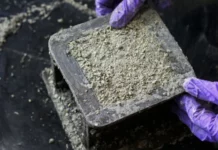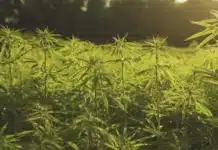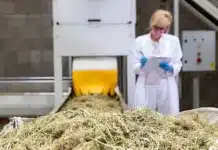Fourth-generation farmer Randy Taylor has watched potential income disappear as a hailstorm obliterated plants on the 7,000 acres that he oversees. But having to destroy crops himself is a tougher pill to swallow.
In December, on what he calls “probably some of the hardest days in my life,” Taylor mowed down eighty acres of hemp that had spiked THC levels. The Colorado Department of Agriculture had told the Yuma farmer that his hemp was too hot, above the 0.3 percent THC limit that defines industrial hemp under state law. Taylor’s crop measured at 0.47 percent THC, over the limit by just 0.17 percent.
Taylor had planned to wait until he’d harvested his other crops before mowing down the hemp, but then a state inspector checking on one of his partner’s facilities noticed that the hot hemp hadn’t been destroyed yet. The inspector called to remind Taylor that the hemp had to go; if he didn’t get rid of it, he faced fines or even prosecution. “Basically, the way the State of Colorado looks at it is, we had pot, not hemp; we had eighty acres of illegal marijuana growing,” Taylor recalls.
Most hot hemp crops occur when farmers are working with a new seed, according to the CDA, but other factors can cause a THC spike in hemp plants, such as the growing environment and overly long flowering periods. Taylor’s crop was made up of Colorado Gold, a hemp strain known for spiking THC levels during the flowering stage.
It was a depressing sight to watch his mower slice through “those beautiful plants,” Taylor remembers. He was raising hemp for its fiber — the stringy outer layer, known as the “baste” — which can be processed into a base ingredient for a vast array of products, including paper, clothing, plastics, auto parts and more. The woody core, or “hurd,” is often used for hempcrete and animal bedding.
Unlike short, busy hemp plants that are grown for their medicinal CBD, Taylor’s hemp plants were twelve feet tall, nearly meeting his eyes when he was perched on his John Deere mower. He took his time destroying them. He’d run the mower for two hours, his son would do a shift, and then they’d call it a day. Neither of their hearts could handle much more than that. “Ask anyone in the country: Who wants to smoke pot that has 0.47 percent THC?” Taylor asks.
But state and federal law dictated that Taylor do away with the crop. Any hemp plant with more than 0.3 percent THC, the psychoactive component, is considered marijuana, not hemp, and is therefore illegal without the licenses required to grow medical or recreational marijuana.
The percentage may seem arbitrary, but there’s history behind it. According to California nonprofit Project CBD, the figure first came from a 1976 article in Taxon, the journal of the International Association for Plant Taxonomy, by Canadian plant scientists Ernest Small and Arthur Cronquist. After that, says CDA spokesman Duane Sinning, it was included in international treaties and adopted by the United Nations Office on Drugs and Crime.
It “becomes a trade thing as much as anything at this point,” Sinning adds.
Colorado adopted the 0.3 percent THC limit before the Farm Bill of 2014 was enacted, allowing hemp to be grown for research in states that allowed it. Sinning says that because there’s no psychoactive effect at that level, entities that regulate and enforce the industry, such as law enforcement, prosecutors and the CDA Industrial Hemp Advisory Committee, don’t see it as a threat to public safety.
Still, Colorado farmers who go over the THC threshold must voluntarily cut down their hemp and submit a disposal plan to the CDA for approval. Sinning notes that this is because disposal must conform to varying local rules as well as three CDA criteria: The hemp can’t be moved, used for human consumption or enter into commerce. Farmers have gotten pretty creative with their disposal plans, he adds. Some work it back into the soil to help aerate their land; one farmer used it to make hempcrete in the foundation of a building that was within the registered farm area. Another plan asked to roll small quantities of hot hemp in paper and incinerate it. “You’ve got to have a sense of humor,” Sinning says.
If the crop is between 0.3 and 1 percent THC, the CDA is in charge of overseeing destruction. If it’s over 1 percent, Sinning says, the CDA contacts farmers to inform them that they could face fines from the department and that law enforcement must be told, which could result in prosecution. If the farmer removes the crop in a timely fashion and there’s no chance it will make it to the gray or black markets, law enforcement authorities will generally stay away and let the CDA handle it, he says.
In the five growing seasons since the November 2012 passage of Amendment 64, which legalized recreational cannabis and hemp in Colorado, the CDA has dealt with just a handful of crops that have spiked over 1 percent, and even fewer over 2 percent, according to Sinning. And only one registrant was forced to hand over his license to grow hemp. After the CDA gave a farmer “ample warning” about his hot crop, Sinning says, the farmer claimed to have submitted a no-trespassing order to local authorities against the CDA and Sinning in an attempt to block the latter from destroying his crop. It didn’t work.
For the most part, though, Colorado hemp farmers abide by the rules. “We deal with some of the most compliant registrants there are,” Sinning says. “We have people calling us, trying to figure out how to do this right.” Around 40 percent of hemp fields failed in the first growing season, he recalls, but that number was down to 7 or 8 percent of 532 registered growing sites in 2017.
Next year Taylor is hoping to plant nearly 200 acres of hemp, and he envisions up to 20,000 acres of the crop around Yuma in years to come — but not if farmers can’t figure out how to keep their crops under the 0.3 percent THC limit. For now, Taylor says, he better understands the CDA processes for growing hemp and how his hemp seed will behave, which will help with next year’s crop. “Farming’s an expensive hobby, as most people call it,” he says. “You’ve got to be crazy [to farm hemp], because most people don’t gamble with the amount of money we gamble with every year.”
That hot hemp crop cost Taylor upwards of $143,000 in future earnings, he estimates, with an up-front investment of $15,000: $10,000 for seed and $5,000 for spraying the field for weeds.
“Lesson learned,” he says. “Do I like it? No. But sometimes you lose a little bit and gain knowledge.” Taylor adds that he would have been “tickled pink” if he’d gotten $600 an acre for the hemp; he says he’d been told he could have gotten about $1,000 an acre for fiber and $500 an acre for flower. In comparison, eighty acres of corn would have cost him nearly $8,000 for the seed alone, which would have yielded 250 bushels an acre at $3.50 each.
But the lost crop cost him in other ways. Hemp has been known to improve soil quality, and it also requires much less water than other crops, according to the Stockholm Environment Institute. “You don’t get to harvest it, but that was the most beautiful hemp field I ever saw,” Taylor concludes. “I was proud.”














